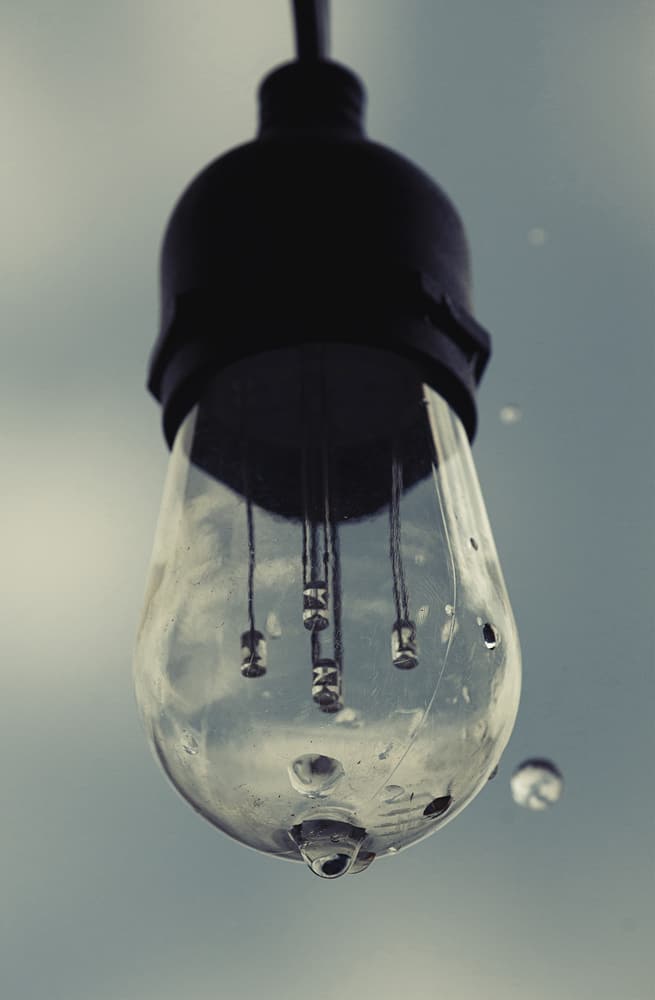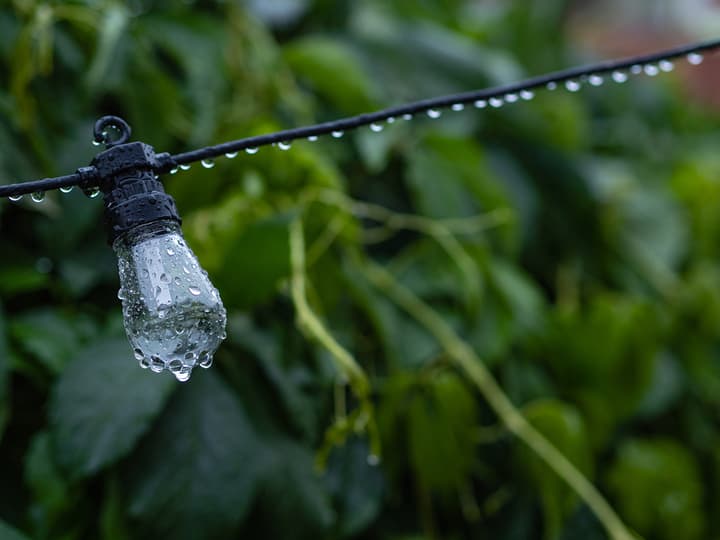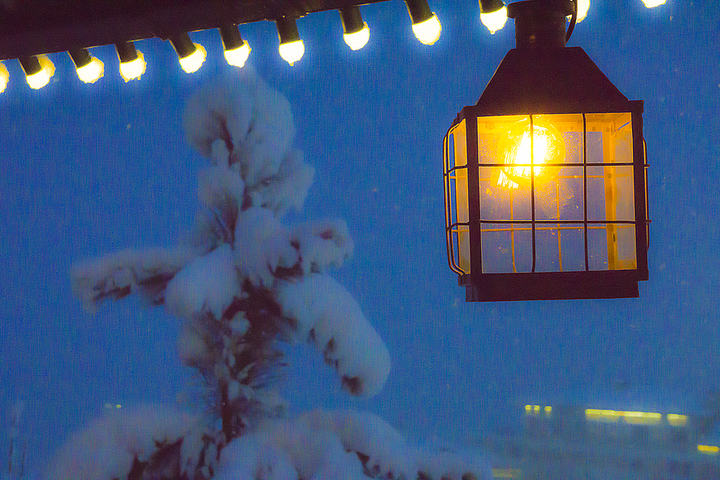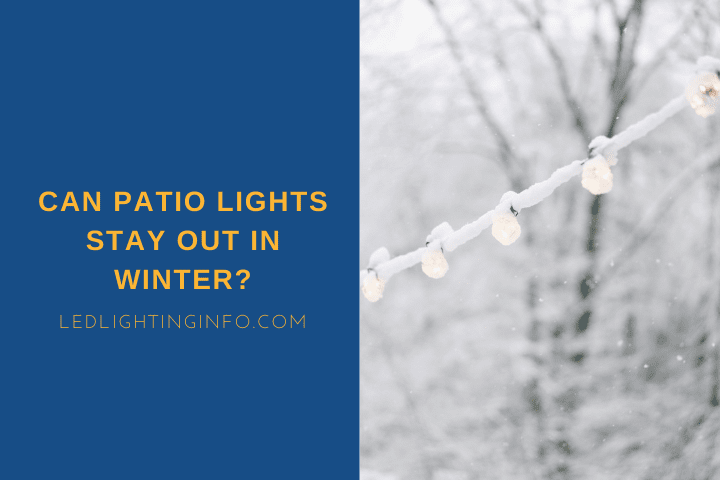Hanging your patio string lights, while not the most time-consuming job in the world, is something that you’d rather avoid having to do every single year if you can.
Patio lights suitable for a permanent installation are much better than any that can only be used in dry conditions.
But can your patio lights be left out during winter, especially if you live somewhere where the weather can turn nasty in the colder months?
Provided you buy properly waterproofed bulbs, they should be fine over winter. IP44 and above are OK during rain, but for snowy temperatures, get IP67 as they’re more tightly sealed and can cope with ice. While LED bulbs work fine in freezing temperatures, the cheap wire could stiffen and crack.
In this article I’ll explain:
- Whether outdoor patio lights are waterproof
- What to do if water gets into your string light bulbs
- If bulbs can survive freezing temperatures (and other inclement weather)
Are Outdoor Patio String Lights Waterproof?

Most patio string lights will be waterproof because they’re designed to be used safely outdoors.
But that doesn’t mean that they definitely will be – the responsibility still lies with you to check before buying.
Some patio lights may be sold to be hung in a sheltered location where water can’t get to them. So they could be advertised as suitable for outdoor use without actually being weatherproof.
What you’re looking for is an IP rating. IP stands for ingress protection and is an international standard code that tells you how resistant/sealed an electrical device is against both solid and liquid materials.
The first digit in an IP rating refers to solids – think dust particles – while the second tells you how waterproof it is. So bulbs rated IP67 are better than IP65-rated ones.
That digit ranges from 0 (not protected against water at all) to 9K, meaning it can withstand high-temperature water jets.
In reality, most lights you see are likely to be rated IP44, IP65 or IP67.
- IP44 – protected against splashing water, will be fine for rainfall providing there is some cover
- IP65 – protected against water jets, will withstand most rain storms
- IP67 – can stand up to water pressure, immersion up to 1 meter for at least 30 minutes
The better rating bulb you can buy, the safer it will be against all types of rainstorms.
If the patio string lights you’re considering buying don’t mention an IP rating, it means they aren’t waterproof and you should buy an alternative.
Water Got Into Patio String Light Bulbs

Water is dangerous for any electrical item. It can cause a short – where the electrical current passes through the water unexpectedly, which causes the power supply to overheat and can start a fire.
So, if you notice that your string light bulbs have water inside them, you need to cut the power immediately.
Make sure you never turn on lights that have water damage.
Now, with the power off, you can investigate the bulbs to see what happened.
Are They Permanently Damaged?
With older light bulbs, the circuitry was exposed within the bulb casing, so water would likely be an instant sign that the bulbs were ruined.
With LED bulbs, that’s not quite the same, as sometimes it’s just the LED chip exposed in the casing, and the actual circuitry is held within the bulb’s base.
If water only got into the bulb casing, and the bulb is hanging down, the light may be repairable.
To do so, you’d have to safely disassemble the bulb to remove the water. So this only works if the casing is removable.
Otherwise, you likely can’t dry the bulb out properly.
With the casing removed, you can recheck the fixture to ensure that no water got into the circuitry.
If you’re sure it didn’t, you could try to dry out the bulb casing entirely before reassembling it and possibly reviving the lights.
But I have to be clear – water is hazardous with electrical items, so you do this at your own risk.
It’s not really safe, and the best option, if water has got into your lights, is to buy new ones.
Only try to salvage the lights if you understand the risk, and you are absolutely certain the circuitry was kept dry.
Can Patio Lights Resist Freezing Temperatures?

Winter isn’t just about rain. There are also the freezing temperatures to contend with.
Most patio string lights these days use LED bulbs – it’s rare to still see any using older halogen tech.
And LED bulbs thrive in cold temperatures with most working fine in temperatures as low as -22°F (-30°C).
However, not all wires are built to the same standards as the LED bulbs.
If you’ve bought cheap patio lights, the wire itself could become damaged by the cold temperatures.
The shielding can stiffen as it freezes and then breaks or crack.
When that happens, suddenly, your waterproof lighting is a whole lot less waterproof since the interior wire is exposed.
If your lighting wire does crack, you need to cut the power and check for any signs of moisture.
You can reseal the wire with liquid electrical tape or waterproof heat shrink, but again this is a risk if you can’t guarantee no moisture has got inside the cable before you reseal it.
If you live somewhere where winters are often below freezing, try to shield your wire.
You can add insulation to protect it from freezing temperatures, which will allow it to be kept outdoors during winter.
One last point often winter storms bring not just cold temperatures but also high winds.
These winds could blow your bulbs around, loosening any installation points and potentially even smashing the bulbs against any surface they are close to.
If heavy winds are forecast, you can temporarily pin any loose sections of cable to nearby surfaces to minimize any swinging.
If you can’t remove the lights, you’ll just need to inspect them once the storm subsides.
Check the bulbs for any signs of damage, and make sure any points where the lights are anchored haven’t weakened.
Final Words
As long as you buy outdoor string lights with a suitable IP rating, they’re durable and can usually be left out all year round.
However, always practice safety, and if you have bad weather, make sure your bulbs haven’t trapped any water.
It’s always worth doing a full inspection of your lights once winter is over, checking the integrity of the bulbs, the connections, and the wire itself.
And if you have any concerns about weather damage and are not completely confident in their safety, don’t take a risk.
Replacing $100 of quality patio lights is better than claiming home insurance because of an electrical fire.
Have you had any weather-related issues with your landscape lighting? Not just string lights, but any outside lights?
Let me know, and if it’s an ongoing problem, I’ll see if I can advise on the best action you could take.

